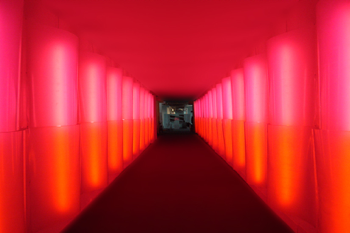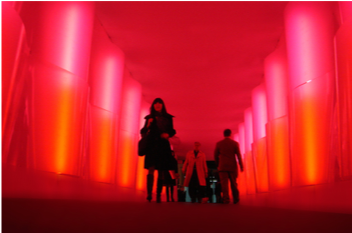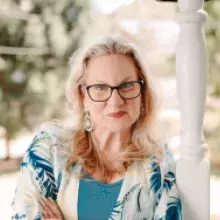Just because you can do something doesn’t mean you should. It’s important to be reminded of this as we get caught up in our ‘can do’ mode tackling projects for which we may not be the best qualified. If you imagine décor and music are all it takes to design experiences, my conversation with Julian Lwin, a spatial innovation and experiential design director, may change your perspective.
Incorporating a professional spatial expert into your program is the human equivalent of adding lemon zest to a dish of fresh vegetables delivering an unexpected but welcome, bright zing of flavor and color.
Here is the second of three excerpts from my conversation with Julian which I’m sharing with the hope that they will enlighten, inspire and bring a dash of flavor, texture, sound and color to your event design process. You can find the first part here.
How does hiring you elevate an experience?
Julian Lwin: I’m lucky enough to work at what I love doing. I am committed to creating the best possible designs and experiences for my clients - the work will be vibrant and dynamic enthused with a curated eye for continuity and relevance. Every aspect of the design journey is scrupulously considered and clients and will find in me a kindred spirit with a desire to deliver excellence far from the banality of mediocre “solutions” that simply get a job done.
How does that translate when trying to measure ROI?
Julian Lwin: Successful brand experiences offer genuine engagement with audiences and attendees. In designing memorable experiences, clients understand the value of empathy. It is this empathy that customers recognize when developing a relationship with a brand - which in turn leads to new and returning business. Banal design experiences isolate customers and do little to engage and retain them. Strategic and well-conceived designs on the other hand have the power to transform events and experiences in to sublime happenings with excitement and a tangible buzz - this is what I strive for in my work and it’s where true return on investment percolates. Current research proves that optimizing engaging customer “experiences” leads to greater brand loyalty and investment.
Does your talent translate to events and tradeshows?
Julian Lwin: Yes, event and tradeshow design are absolutely services I offer. Creating environments for an event or trade show are great opportunities to encapsulate thematic elements or “brand essence” in to a succinct experience. Herein lies the magic where visceral brand engagement is sown in to the design experience right from the concept stage. I design temporary events and trade shows of any scale quickly and efficiently with fun, elegance and distinction.
What’s the design/experience you created of which you are most proud?
 Julian Lwin: I created a 200’ immersive sensory tunnel art
Julian Lwin: I created a 200’ immersive sensory tunnel art  installation experience for the Pulse Contemporary Art Fair in NYC. The design utilized undulating translucent panels filled with sumptuous color and lighting. The concept was to combine the use of color and subliminal soundscapes to calm and restore the visitors on their journey. The project created a transitional space leading from the busy West Side Highway in NYC to the art fair housed in the Chelsea Piers along the Hudson river. Installed in one day the tunnel resulted in a magical and other worldly transit experience for over 7000 attendees.
installation experience for the Pulse Contemporary Art Fair in NYC. The design utilized undulating translucent panels filled with sumptuous color and lighting. The concept was to combine the use of color and subliminal soundscapes to calm and restore the visitors on their journey. The project created a transitional space leading from the busy West Side Highway in NYC to the art fair housed in the Chelsea Piers along the Hudson river. Installed in one day the tunnel resulted in a magical and other worldly transit experience for over 7000 attendees.
What other ways can event strategists utilize your talents that they may not be thinking of?
Julian Lwin: Successful events use design to craft the tonality for each event with a unique personality and coherent brand message - these are integral event planning considerations. offers an acute awareness of contemporary culture and current trends in music and materials to colors, fabrication and presentation techniques. Applying appropriate design from the initial event invitation (when first impressions make a considerable impact) to designing transportation logistics illustrates that design becomes the axis from which all event elements filter through. Design psychology and consumer insight are valuable tools when considering innovative event technologies from data analytics to on-stage presentation technologies. There is no doubt about it - designers and event strategists are a perfect team - uniquely qualified to partner their skillsets to create seamless events and experiences.


 Julian Lwin: I created a 200’ immersive sensory tunnel art
Julian Lwin: I created a 200’ immersive sensory tunnel art  installation experience for the Pulse Contemporary Art Fair in NYC. The design utilized undulating translucent panels filled with sumptuous color and lighting. The concept was to combine the use of color and subliminal soundscapes to calm and restore the visitors on their journey. The project created a transitional space leading from the busy West Side Highway in NYC to the art fair housed in the Chelsea Piers along the Hudson river. Installed in one day the tunnel resulted in a magical and other worldly transit experience for over 7000 attendees.
installation experience for the Pulse Contemporary Art Fair in NYC. The design utilized undulating translucent panels filled with sumptuous color and lighting. The concept was to combine the use of color and subliminal soundscapes to calm and restore the visitors on their journey. The project created a transitional space leading from the busy West Side Highway in NYC to the art fair housed in the Chelsea Piers along the Hudson river. Installed in one day the tunnel resulted in a magical and other worldly transit experience for over 7000 attendees. 